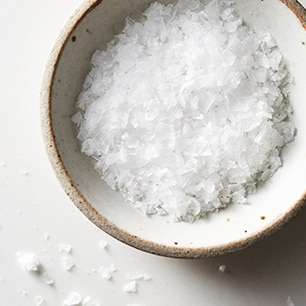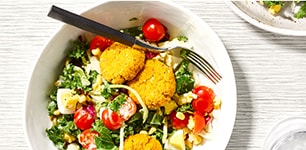Did you know that 46% of Americans—nearly half—have high blood pressure? Though many people don’t even know they have it, high blood pressure may increase the risk of heart attack or stroke.1 Check out these blood pressure guidelines to see where you are.
Lifestyle changes—including these six steps—are the key to lowering high blood pressure and maintaining healthy blood pressure. Lowering your sodium intake is a great start. Our dietitians have some shopping and food preparation strategies for reducing sodium in your diet.

Sodium Guidelines
The Dietary Guidelines for Americans 2015–2020 recommends less than 2,300 milligrams of sodium per day for adults and children 14 and older. For those with high blood pressure, an optimal goal is less than 1,500 milligrams of sodium per day.2 Depending on your specific needs and health, a doctor or dietitian can recommend a sodium intake level that’s right for you.
Reducing Sodium While You Shop
Now that you know your limits, it’s time to put sodium reduction into practice on a daily basis. It all starts with how you shop. Join us for a walk through the aisles to learn how to find lower-sodium options and how to spot sneaky sources of sodium.
In the Deli
Filter away. Look for meats and cheeses with less sodium. Use the filter function in our online product catalog to select items that meet your sodium requirements. When ordering for in-store pickup, filter by the amount of sodium to help you zero in on the best choices.
Pair wisely. When picking up our convenient prepared foods, check the sodium levels. If some items have moderate amounts of sodium, pair them with lower-sodium foods to keep your meals in check.
Meal idea: Take a Deli Oven Roasted Chicken, quarter breast (560 mg sodium) and pair it with our Mixed Berry Salad (490 mg sodium). Divide the meal into two portions to share with a family member.
In the Grocery Aisles
Pay attention to the claims on packaged items to help you find foods with less sodium. Use this key to keep track of common sodium claims and what they mean:
- Sodium-free or salt-free = less than 5 mg sodium per serving
- Very low sodium = 35 mg sodium or less
- Low sodium = 140 mg sodium or less
- Reduced sodium or less sodium = at least 25% less sodium than the regular version
Sneaky Sodium Sources
Some of the products you might not expect to have sodium may contain more of it than you want. Here are some examples and alternatives or solutions.
Hot cereal such as oatmeal: Replace instant flavored varieties with plain old-fashioned or quick-cooking oatmeal.
Breads, bagels, pancakes, and waffles: Because these items have leavening agents, they also contain sodium. Select the lower-sodium products. Use our Better Choice shelf tags to help locate them.
Sauces and condiments:
- For pasta sauces, use our Better Choice shelf tags to identify options with less sodium. Or make your own sauce at home using less salt.
- Condiments such as soy sauce, bottled salad dressings, dips, ketchup, jarred salsas, capers, mustard, pickles, olives, and relish can be very high in sodium. Look for a reduced or lower-sodium version. Check the labels and be mindful of your portion size.
- Combine olive oil, citrus juice, and fresh or dried herbs for a homemade salad dressing that’s low in sodium.
Other Sodium Culprits
Canned goods:
- Choose no salt added, low-sodium, or less sodium canned vegetables and beans. Or drain and rinse them to cut the sodium by up to 40 percent. Include them in soups, stews, and casseroles.
- Some canned soups have 1,000 milligrams of sodium or more per serving! Look for low- and lower-sodium varieties. Or make a large batch of homemade soup using no salt added or less sodium broth or stock. Add just enough salt to taste, and freeze it in individual serving containers for convenience.
Nuts, seeds, and nut butters: Pick unsalted or lightly salted nuts and seeds. Compare labels and find nut butters that are lower in sodium. Spot them quickly with our Better Choice shelf tags.
Snacks: When it comes to salty snacks such as pretzels, chips, and crackers, there are lower-sodium options. Check labels or use Better Choice shelf tags, and be mindful of your portion size.
Grains:
- Seasoned and packaged rice and pasta mixes can be high in sodium. Select the ones with less sodium. Or simply choose plain pasta, rice, and quinoa.
- Prepare grains without salt. You’re likely going to add other flavorful ingredients or sauces.
In Frozen Foods
Family and individual frozen meals: Better Choice shelf tags can help you select frozen meals with less sodium.
Frozen vegetables: Discover varieties that are lightly sauced or seasoned with herbs. The Better Choice shelf tags can help you locate them.
In Meat and Seafood
Be picky about poultry. Avoid fresh and frozen poultry that has been injected with a sodium solution by checking the fine print on the packaging for ingredients such as broth, saline, or sodium solution. Sodium levels in unseasoned fresh meats are around 100 milligrams or less per 4-ounce serving.3 Our Publix brand and GreenWise fresh chicken—as well as GreenWise frozen turkey—do not contain sodium solutions.
Watch sodium in seafood. Some shrimp is processed with a preservative containing sodium, so be sure to check ingredients for options with less sodium. Our GreenWise shrimp is processed without these preservatives.
Choose well. Bacon and sausage tend to be high in sodium, but there are varieties that qualify for our Better Choice shelf tags. Spot these icons in our stores and online.
Preparation matters. When cooking meat and seafood, use less salt by adding spices, fresh and dried herbs, citrus juice, and vinegar for flavor.
Meal Planning with Less Sodium
As you keep track of your sodium intake when combining foods, try these go-to meals with less sodium.
4 Breakfast Ideas
- Enjoy easy-to-prepare old-fashioned or quick-cooking oatmeal topped with fresh fruit and a hard-boiled egg.
- Our Apple Pie Pancakes with Turkey Bacon recipe includes turkey bacon with only 150 milligrams of sodium per slice.
- Make a plant-based brunch with Chipotle-Sweet Potato Hash Bowls featuring sweet potatoes, bell peppers, tomatoes, and vegetarian sausage.
- Use reduced sodium ham in our Eggs in a Nest recipe. These can be made ahead of time for a quick grab-and-go breakfast option.
Smart Swaps for Family Meals
With a few simple substitutes, you can lower the sodium in these family favorites.
Taco Tuesday: Tacos are tasty, but they combine several high-salt ingredients, such as white flour tortillas (an 8-inch diameter one contains about 400 milligrams of sodium), cheese, beans, and meat.
- Start with whole-grain corn tortillas filled with grilled chicken or a mild white fish. Add low-sodium canned beans, and top with chopped vegetables, salsa, and avocado.
- Enjoy a new recipe! Our Smoked Paprika Fish Tacos with Black Bean-Pineapple Salsa includes corn tortillas and fish fillets.
Pizza pizzazz: The usual pizza crust, sauce, and cheese contain a lot of salt. Cured meats such as pepperoni or sausage add even more sodium.
- Make a homemade pizza with ingredients that are lower in sodium, including a thin crust, pizza or pasta sauce, and finely shredded cheese. Top it with sliced bell peppers, mushrooms, or any other vegetables you like.
Asian influences: Asian takeout food is often very high in sodium.
- Cook Asian dishes at home with less sodium. Start with our Teriyaki Shrimp and Vegetable Rice Bowl.
Pasta extravaganza: Traditional spaghetti with premade meatballs and sauce can be high in sodium.
- Better Choice shelf tags can help you identify sauces with less sodium. Make your own meatballs or use lower-sodium meats such as GreenWise chicken.
- Our Chicken Bolognese over Pasta recipe features unsalted tomatoes and a salt-free garlic and herb seasoning.
Bountiful bowls: Bowls are all the rage on today’s menus, but restaurants don’t always keep sodium in check. Take control of sodium content by putting a bowl together at home with your favorite ingredients for a quick and easy meal.
- Dig in to our new Summer Sweet Potato-Falafel Bowls for a vegetarian option featuring sweet potatoes, corn, and brown rice.
For the Love of You
Choosing how you eat is uniquely personal. It’s about your needs, your preferences, and your goals. As your wellness ally, we're in your corner with fresh ideas, recipes, and wellness icons that make it easier to shift toward wiser food choices. It’s all about you, at your very best.
Sources
1 Ferdinand, Keith C., MD, FACC, FAHA. High Blood Pressure. CardioSmart.org. June 2016.
2 U.S. Department of Health & Human Services (HHS). A Closer Look Inside Healthy Eating Patterns. 2015-2020 Dietary Guidelines for Americans, 8th ed. November 21, 2016.
3 How to Reduce Sodium. American Heart Association. May 23, 2018.

 You are about to leave publix.com and enter the Instacart site that they operate and control. Publix’s delivery and curbside pickup item prices are higher than item prices in physical store locations. Prices are based on data collected in store and are subject to delays and errors. Fees, tips & taxes may apply. Subject to terms & availability. Publix Liquors orders cannot be combined with grocery delivery. Drink Responsibly. Be 21. For prescription delivery, log in to your pharmacy account by using the Publix Pharmacy app or visiting
You are about to leave publix.com and enter the Instacart site that they operate and control. Publix’s delivery and curbside pickup item prices are higher than item prices in physical store locations. Prices are based on data collected in store and are subject to delays and errors. Fees, tips & taxes may apply. Subject to terms & availability. Publix Liquors orders cannot be combined with grocery delivery. Drink Responsibly. Be 21. For prescription delivery, log in to your pharmacy account by using the Publix Pharmacy app or visiting 
